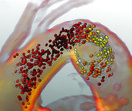Winners
The Computer Graphics Forum 2012 Cover Image has been selected by the CGF editorial board. We thanks all people who submitted this year, and hope that they will participate to the next year contest.
Winner of the Computer Graphics Forum 2012 Cover Image Contest

Adrien Bousseau (1), Emmanuelle Chapoulie (1), Ravi Ramamoorthi (2) and Maneesh Agrawala (2)
(1) REVES - INRIA Sophia Antipolis
(2) UC Berkeley
This image has been produced by the method described in our paper "Optimizing Environment Maps for Material Depiction" published at EGSR 2011.
Our method automatically optimizes the lighting to enhance material-specifc visual features. The lighting reveals the thin and thick parts of the subsurface scattering wax candle, it accentuates the Fresnel refections along the side of the
porcelain vase and it adds strong specular highlights to emphasize the shiny chrome metal of the sculpture. We use the PBRT raytracer to render the image under our optimized environment map. The sculpture model was provided by the AIM@SHAPE project.
Second place:

Roy van Pelt and Anna Vilanova
Eindhoven University of Technology
The submitted figure shows the course of pathological blood flow in the aortic arch of a patient. The volumetric and time-resolved blood-flow field was acquired using magnetic resonance imaging (MRI), quantitatively capturing the blood-flow velocities. The flow is visualized interactively using GPU-based illustrative particles, which elongate when the speed increases. In this case, the speed is also encoded by the particle color, along a black-body color map. The direction is clarified by means of speed lines, inspired by comics. In addition, there is an anatomical context, based on a real-time gradient volume raycasting of the luminal geometry. The visualization framework was implemented in C++, with OpenGL and GLSL, intensively employing the geometry shading stage.
Third place:

Frank Bauer (1), Martin Boss (2), Günther Greiner (1), Marc Stamminger (1), Jochen Süßmuth (1) and Michael Zollhöfer (1)
(1) Computer Graphics Group, Erlangen
(2) Department of Archaeology, Erlangen
Archaeologists distinguish the different types of portraits of Emperor Augustus primarily by counting the various strands of hair. Little effort was made to capture his identity using the characteristic geometry of his face. What makes humans - his fellow Romans as well as ourselves 2000 years later - recognize his portrait at the first glance? Which of the statues' features were inspired by the classical concept of beauty and god-like appearance, and which features can be attributed to the real Augustus.
Therefore, Archaeologists and Computer Scientists at the University of Erlangen Nuremberg have started a unique project to scan busts of the famous emperor all over the world. By fitting a common template mask to all acquired scans by means of non-rigid registration, a dense set of correspondences between the different portraits is obtained. These correspondences make it possible to compute a statistical model of Augustus, which can be used to objectively distinguish himself - and his family - from portraits of other classical rulers.
The cover image shows 4 scans from the database our statistical model is built upon as well as one adapted template mask. Since the template is equipped with semantic information, we can further use the mask to transfer facial expression onto the ancient artefacts - in this case obtaining a smiling statue.
